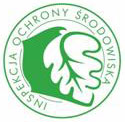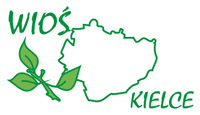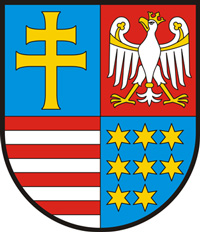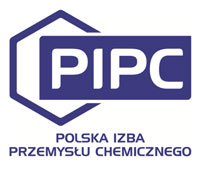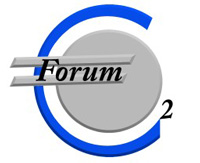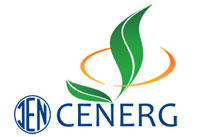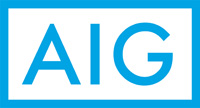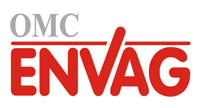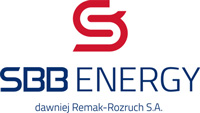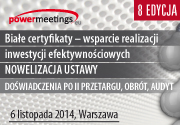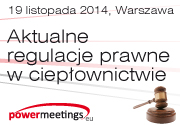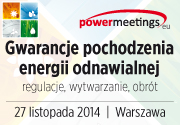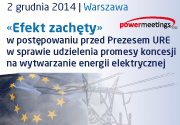Environmental Protection Forum: a summary report
New, essential and increasingly sharp environmental challenges versus the opportunities and pragmatics of their industrial implementation: this was the main slogan of the Environmental Protection Forum, which was held on 6th–7th November 2014 in Sandomierz, Poland. The powermeetings.eu Team has once again created an opportunity for an interesting content-related debate attended by experts.
The Ożarów S.A. Group acted as the Honorary Host of this conceptually unique event which attracted a quite a large group of experts and guests from all over Poland. It was on initiative of the Group that representatives of the industry, local authorities, Polish Ministry of the Environment, industrial/sectoral associations, and more, have been invited to discuss about the aspects that, in spite of considerable outlays and expenses, have absolutely to be taken into account by those responsible for environmental protection in Polish enterprises.
Mr. Andrzej Ptak, President of the Management Board/CEO,Grupa Ożarów S.A., and Chairman of the Cement Manufacturers’ Association, described in his opening presentation the position of the cement industry in Poland. As he highlighted, “owing to numerous upgrade projects, the cement plants in Poland rank among the most modern such establishments in Europe. This enables universal application of the energy recovery of waste in clinker calcining furnaces, whilst some of our cement mills, ranking among the most technologically advanced works in Europe, gain over 80% energy based on alternative fuels. The manufacture of cement clinker requires the temperature of 1450°C; the flame is even warmer – 2000°C. The temperatures of this range, combined with the long time spent by the gases inside the furnace, ensure complete combustion of the organic parts. The environment inside the furnace is highly alkaline, which neutralises the gases. No residues, such as ashes, are produced, as they remain bound within the clinker.”
Ms. Małgorzata Typko, Director of the Environmental Protection Department, the Ministry of the Environment, discussed the amendments to the Polish Environmental Protection Law in the context of entities intervening in the environment and focused on the IED Directive, including BREF and BAT. She also mentioned the new soil and underground waters protection obligations, being one of the major tasks imposed on industrial installations and systems. The related initial report has triggered much concern among the industry actors, as it implies considerable cost related to its compilation. “For the report to be obligatory, four conditions have to be met: (i) the installation or system needs an integrated permit obtained; (ii) the operation of such installation/system encompasses the use, production or release of risk-causing substances; (iii) contamination/pollution may occur; and, (iv) the latter is true for the establishment’s area. Each application for issuance or modification of the integrated permit should comprise an analysis of the need for compiling the initial report, once the Law has entered into force”, Ms. Typko remarked.
The legal basis for the environmental security is determined by Directive 2004/35/EC of the European Parliament and Council of 21st April 2004, as implemented in the Polish legislation by means of the Law of 13th April 2007 ‘on prevention of damages to the environment and their rectification. Some twelve years later, two important pieces of secondary legislation were made effective: the Ordinance of the Minister of the Environment of 30th April 2008 ‘on the criteria of evaluation of occurrence of damage in the environment’; and, the Ordinance of the Minister of the Environment of 4th June 2008 ‘on the types of rectifying actions and the conditions and methods of their conduct.
Mr. Paweł Holnicki-Szulc,Regional Director, AIG, responsible for the development of environmental insurance, reminded that, according to the aforesaid Law, the entities using the environment are responsible for causing environmental damages or immediate threat related to a damage. Environmental damage may refer to four areas: the surface of earth, waters, protected species, or protected natural habitats. With the ‘polluter pays’ principle in mind, the costs of preventive or rectifying actions are always borne by the entity that uses the environment. As per the Law, taking rectifying actions requires that their terms-and-conditions be agreed with the Regional Director for Environmental Protection, as the environmental authority. The AIG-man also reminded the attendees about common access to the information on the condition and protection of the environment (under Article 74, clause 3 of the Constitution of the Republic of Poland). Such ‘information on the condition and protection of the environment’ should be understood to mean any information regarding a given environment (or its element) and its condition, evaluations, intended/designed purpose or use, envisioned impact and measures counteracting such impact. While the information is, generally, overt, there are instances – such as protection of public security or of the rights of the others, environmental protection and ecological safety, or commercial confidentiality – for which exceptions to the access rule have been specified. Paweł shared with the audience a few examples of environmental damages, incl. the disaster in Gutkowo and the 2012 accident in Wilczowola. He emphasised that environmental damages are rectified over long years and call for enormous money invested. AIG has in its offer various mechanisms to insure environmental risks; their detailed specifications are obtainable directly from the Insurer.
Mr. Ludomir Błeszyński of Siemens focused on energy efficiency in industrial installation’s lifecycle as an environmental policy element, thus referring to COMOS software offered by Siemens. The integrated software’s uniform data platform enables designers, operators and assemblers to take advantage of fluent flows of pieces of information and data critical to the project across the corporate levels and project stages. Efficient management of the appliance calls for optimum integration and coordination of all the branches involved in the planning and running of the system. COMOS offers a foundation for global cooperation of various branches throughout the device’s lifecycle. The object orientation concept ensures universal integration of integration of application. Object means, in this case, presentation of a given part of the appliance in a graphic form and using relevant technological data. The related datasheets, lists, and other documents are directly connected with their respective objects, thus forming a unity.
Storing the complete information on the system in its central database, COMOS always enables access to the same data to all the branches taking part in the project in the course of planning and at the operating phase. Objects may be edited in two ways – either as datasheets or as technical drawing. Any modifications in the objects or documents are thus accessible, on an ongoing basis, to any user at any moment worldwide, regardless of the time zone. The whole system, with its individual parts, may be used in this way and developed according to its functions, taking all its sections into account.
Owing to the system’s open architecture, COMOS is ideally customisable to the specific requirements of enterprises and/or connectable with legacy external IT systems.
The most recent trends in environmental measurement techniques was the topic of the presentation delivered by Mr. Dariusz Janasz, Senior Sales & Marketing Expert for Measurement Appliances and Process Analytics with ABB. He discussed, among other things, the potential and functions of EasyLine and Advance Optima analysers and the complete (turnkey) system ACF5000.
Mr. Marcin Żak, Operations Manager, Emission Measurement Laboratory WESSLING (Poland) Sp. z o.o. focused on presentation of the AST, QAL2 and QAL3 procedures, in line with the PN-EN 14181 standard. His detailed clarification of these procedures was accompanied by an explanation of the legal basis behind PN-EN 14181:2010 and the scope of the standard itself. Marcin has also opened a discourse concerning the requirements posed to laboratories pursuing the AST and QAL2 procedures.
The speaker focused next on aspects of SRM methodology, employed by research laboratories, as well as by functionality tests for AMS systems.
Marcin made a special remark on the work (underway) on amended Ordinance of the Minister of the Environment of 4th November 2008 ‘on the requirements regarding the conduct of measures of emissions and water consumed’, which will impose on the system/installation owner the obligation to follow the QAL3 procedure, and is expected to come into force as from 1st January 2016.
Mr. Włodzisław Ćwiąkalski, Chairman of EMIPRO, discussed the influence of modern flue-gas dedusting methods on the volumes of pollutant emissions with respect to emission standards for waste co-combustion systems. EMIPRO’s operations extend to design, delivery, assembly and start-up of ‘green’ installations and systems, mainly those purifying the air of various technological processes. The company is commissioned by its clients with compiling environmental studies and documentation, of any sort, as required under the binding laws – e.g. environmental impact report, integrated permit application, or environmental audit.
Mr. Robert Żmuda, head of Development Section at SBB ENERGY S.A., discussed operating costs and investment outlays in various flue-gas denitrification methods. He focused on the need to satisfy the emission requirements imposed by IED Directive as from 2016 as well as those forecasted by BREF for LPC, pointing to the optimum solutions: secondary catalytic methods and their combinations with primary and secondary non-catalytic methods. Robert moreover showed a detailed economic analysis of costs/expenses related to the application of specified options, discussing the strong and weak points of each proposed solution.
Mr. Patryk Weisser of the Institute of Ceramics and Construction Materials described the activities and areas of scientific research pursued by his Institute. The Institute has a professional offer for the industry, which includes research and testing of environmental protection appliances and installations/systems, environmental monitoring devices, contaminations in exhaust gases, noise measurements in the environment, and waste/compost examination.
Methods of permanent metering of exhaust gases enabling control of desulphurisation, denitrification and dedusting systems as well as monitoring of pollutions and contaminations were the topics of the presentation delivered by Mr. Marek Grzesiuk of OMC ENVAG. Day 1 of the Forum agenda, abounding with issues of environmental protection in enterprises, was complemented by a presentation on the air quality monitoring system used in Świętokrzyskie Province; the speaker was Ms. Joanna Jędras, Deputy Head of the Environmental Monitoring Section, Provincial Inspectorate for Environmental Protection in Kielce.
A real success in business is owed not only to a leading market position and growing stock-exchange indices; it is also based on the skill of combining economic efficiency and responsibility for natural environment, plus public trust toward the enterprise’s activities and operations; this is what the CRH concern would not neglect in Poland. The Forum attendees could take a closer look at the SNCR system and at the ways alternative fuels are utilised in the production process employed by Ożarów S.A. Group. These presentations were made by Mr. Piotr Gozdek, Shift Manager, Manufacture and Co-Combustion Department, Mr. Zdzisław Hoda, Manager, Manufacture and Co-Combustion Department, Grupa Ożarów S.A.
The importance of alternative fuels for power industry was covered also by Mr. Józef Mokrzycki, Chairman of the Management Board, MOBRUK S.A. (MOBRUK’s incineration plant is Poland’s second largest such installation; the enterprise has recently invested in a new alternative fuel production line and an RDF storage room.) Mr. Mokrzycki reminded that from 1st January 2016 onwards, there is a ban in force on disposing municipal waste of caloricity above 6 MJ/kg at landfill sites. “The waste out of which we manufacture alternative fuels today have a caloricity above 14 MJ//kg. In order to acquire such fuels, we have to compete against landfill sites. January 2016 will see the appearance of more than 4.8 million Mg of waste not to be disposed. One way of handling it will be to process such waste into alternative fuels or have it combusted by municipal waste incineration plants”, he emphasised.
According to Deloitte, the so-called combustible fraction, potentially the raw material for alternative fuels, accounts for over 30% of the municipal waste stream. Considering the fact that approx. 12 Mio. Mg municipal waste is produced in Poland, some 3.6 Mio. Mg can be used for alternative fuel production purposes (against approx. 1.0 Mio. Mg used today). Selective collection and sorting of municipal waste have nonetheless caused a remarkable deterioration of the quality of this particular raw material.
“Owing to the advantageous difference in the price, alternative fuels are successfully replacing coal”, Józef continued. “The Chełm Cement Mill, our customer, member of CEMEX, has multiplied in the last ten years its use of alternative fuels in the clinker calcination process, reaching 319,000 Mg/year in 2011, and arriving at a 74% coal replacement. Cements mills today reprocess approx. 1.0 Mg RDF per year, their maximum estimated capacity being 1.5 Mio. Mg”.
In his opinion, the total manufacturing capacities installed at alternative fuel producers are estimated at 1.5 Mio. Mg. These capacities are not used as there is scarcity of waste in the market.
Loss of the status of waste, side products, waste registration with REACH and, finally, REACH and CLP Regulations were the topics covered by Ms. Monika Wasiak-Gromek, Section Head, National REACH and CLP Information Centre; member of Hazardous Substances and Mixtures Department, Office for Chemical Substances. Monika embarked on an attempt to disentangle the long-time issue bothering industrial enterprises: ‘a substance, or piece of waste?’. Consequently: ‘Am I bound by the REACH Regulation, or by the Waste Law?’. “It is your enterprise that should analyse, on its own, what meets and what does not meet the definition of ‘waste’ within its boundaries; again, what has lost the status of ‘waste’ and whether the recovery process is applied. The further procedure will be conditional upon the decision you have made. In case the enterprise, based on its knowledge and binding regulations, has decided that it has (a piece of) waste, then it has to apply the waste regulations; if there is a substance, rather than waste, the REACH Regulation becomes applicable”, Monika concluded.
A very important moment of the Forum was the panel discussion, headed ‘Forum of Thoughts & Ideas: Environmental challenges for the future versus the mental capacities and the pragmatics of implementation of challenges in the industry’, moderated by Mr. Mirosław Niewiadomski, Head of Environmental Protection Office, PGE GiEK S.A. An introductory presentation was made by Mr. Mieczysław Kobylarz, Director, Office of Production, Quality, Environment and Health-and-Safety-at-Work Support, Suez Energia (Poland) S.A., who discussed the impact of the ongoing modifications of the Environmental Protection Law on the activity costs/operating expenses of Połaniec PP related to compliance with the binding standards.
The first day of the deliberations concluded with a solemn dinner; the attendees joined a speed dating session, which turned out to be a brilliant idea facilitating the exchange of business cards and establishing of new business contacts.
Day 2 was opened by a presentation by Ms. Marzena Jasińska-Łodyga, Environmental Manager with Ożarów S.A. Group. Referring to the previous addresses and presentations of Andrzej Ptak and her other colleagues of the Manufacture and Co-Combustion Department, she emphasised that “sustainable development means equal treatment of the environmental, economic and social, or public, reasons. Ożarów S.A. Group approaches this idea as an essential element in its corporate strategy; many of its initiatives go beyond the limits of legal requirements, reaching for innovative ideas. Our factories make use of biomass, replacement fuels, and other alternative materials. From the standpoint of carbon emission, biomass is neutral to the environment. Alternative fuels enable reduction of total emissions and diminished quantities of waste carried away to landfills.”
The next panel of the Forum’s second day concerned the challenges for the industry which are potentially implied by the climate and energy package under negotiation at the EU level. Ms. Beata Brynczak and Ms. Karolina Ubysz, lawyers of the Brynczak Ubysz Legal Counsels, discussed the legal aspects of the operation of the greenhouse gas emissions allowance trading system.
Beata focused on the problem of carbon leakage – particularly, the procedures related to identifying the sectors exposed to the leakage risk, which therefore receive a certain number of GHG emission allowances. She discussed the legal framework for the allocation of such allowances, EU procedures regarding the decisions issued by the European Commission and the practical significance of these regulations for entrepreneurs. The need was pointed out to join and participate in the procedures and proceedings that effectively directly inform the legal and financial situation or standing of the enterprises concerned.
The lectures over, Karolina Ubysz summarised the meeting, pointing to the essential role of environmental regulations on the industry, in Poland and elsewhere. Together with her associate Monika and other attendees of the event, she facilitated a discussion which turned into an exchange of views and ideas touching upon the subject-matters covered during the two Forum days. The dominant threads concerned the level of restrictions in environmental law and standards imposed by EU institutions and the adequacy and commensurateness of these actions with respect to the domestic and international realities. The contributors also pointed out to certain concerns in respect of adverse influences of these regulations on the industrial sector’s business condition. Another interesting motif concerned actions and good practices aiming at fulfilling the superimposed standards. Among the topics touched upon in the course of the discussion was the topical question of directions of international actions taken with respect to counteracting climate change. The debate was concluded with a postulate that legislative initiatives at the EU level be monitored. It is moreover necessary for entrepreneurs to broadly participate in, and contribute to, discussion forums and view/opinion exchange platforms, so as to exert real impact and have a say in creating and developing future solutions.
The Forum was crowned with a site visit to Ożarów Cement Mill, which was willingly joined by the participants.
This article has been based on the lectures and materials of the Environmental Protection Forum, organised by the powermeetings.euTeam and held 6th–7th November 2014 in Sandomierz, Poland.
The Environmental Protection Forum is over now. May all the participants and attendees, speakers, and the discussion panel facilitator be thanked for their participation in this event, which turned out to be quite unique. It was a pleasure to host you with us and listen to your interesting observations and opinions, and partake in the discussions. As we have learned from our dear guests, it was a well-invested time, used to broaden their knowledge, exchange the experiences, and meet interesting people. We entertain the hope that all this will translate, for all of you, into perceptible business advantages, and encourage you to cooperate with us once new projects appear.
Our Forum enjoyed support from several Honorary Patrons, partner enterprises media partners, all of which have made a contribution to the November event.
The powermeetings.euTeam extend their thanks to the Honorary Host – Grupa Ożarów S.A. for their valuable support in the organisation of the Forum.
We are extremely pleased to have received Honorary Patronage from the Chief Inspector of Environmental Protection, the Świętokrzyskie ProvinceInspector of Environmental Protection,the Marshal of the Świętokrzyskie Province, the Cement Manufacturers’ Association,the Polish Chamber of Chemical Industry, Forum CO2, and ‘Polskie Szkło’ [Polish Glass] Employers’ Association.
Our special thanks go to WESSLING Polska Sp. z o.o., the Chief Partner of the Environmental Protection Forum.
We are proud that involvement in the Forum has come from Partners such as: AIG, EMIPRO, Institute of Ceramics and Construction Materials, SIEMENS, ABB, and OMC ENVAG.
All the other institutions and businesses engaged in collaboration with us, including: the Ministry of the Environment (Republic of Poland), GDF SUEZ, SBB ENERGY, MOBRUK, and INSTAL-FILTER have deserved our warmest thanks.
We are glad that our undertaking has received support from the mass media. Our Media Patrons have been: gramwzielone.pl, energiamax.pl, portalenergia.pl, rynekinwestycji.pl, środowisko.abc.com.pl, and cenerg.ien.com.pl. Thanks!
We invite you cordially to further cooperate with us and to contribute to, and participate in, more shared projects to come!
The next edition of the Environmental Protection Forum is due in less than a year: 5th–6th November 2015. See you then!
Agnieszka Kozłowska
Project Manager,
Powermeetings.eu
Renata Kałużna
Managing Director,
Powermeetings.eu


